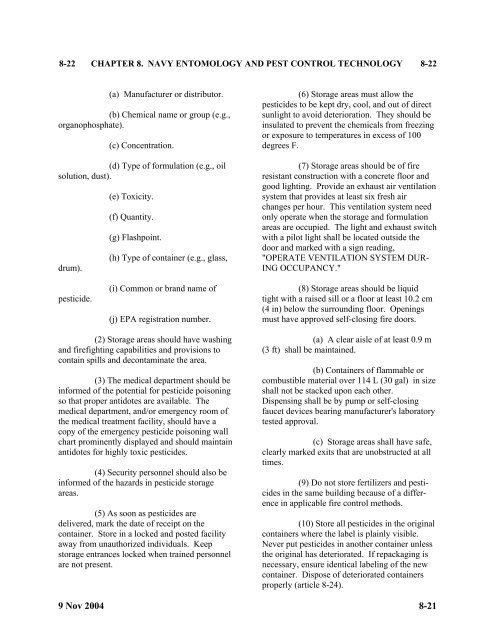NAVMED P-5010-8 - Navy Medicine - U.S. Navy
NAVMED P-5010-8 - Navy Medicine - U.S. Navy
NAVMED P-5010-8 - Navy Medicine - U.S. Navy
You also want an ePaper? Increase the reach of your titles
YUMPU automatically turns print PDFs into web optimized ePapers that Google loves.
8-22 CHAPTER 8. NAVY ENTOMOLOGY AND PEST CONTROL TECHNOLOGY 8-22<br />
(a) Manufacturer or distributor.<br />
(b) Chemical name or group (e.g.,<br />
organophosphate).<br />
(c) Concentration.<br />
(d) Type of formulation (e.g., oil<br />
solution, dust).<br />
drum).<br />
(e) Toxicity.<br />
(f) Quantity.<br />
(g) Flashpoint.<br />
(h) Type of container (e.g., glass,<br />
(6) Storage areas must allow the<br />
pesticides to be kept dry, cool, and out of direct<br />
sunlight to avoid deterioration. They should be<br />
insulated to prevent the chemicals from freezing<br />
or exposure to temperatures in excess of 100<br />
degrees F.<br />
(7) Storage areas should be of fire<br />
resistant construction with a concrete floor and<br />
good lighting. Provide an exhaust air ventilation<br />
system that provides at least six fresh air<br />
changes per hour. This ventilation system need<br />
only operate when the storage and formulation<br />
areas are occupied. The light and exhaust switch<br />
with a pilot light shall be located outside the<br />
door and marked with a sign reading,<br />
"OPERATE VENTILATION SYSTEM DUR-<br />
ING OCCUPANCY."<br />
pesticide.<br />
(i) Common or brand name of<br />
(j) EPA registration number.<br />
(8) Storage areas should be liquid<br />
tight with a raised sill or a floor at least 10.2 cm<br />
(4 in) below the surrounding floor. Openings<br />
must have approved self-closing fire doors.<br />
(2) Storage areas should have washing<br />
and firefighting capabilities and provisions to<br />
contain spills and decontaminate the area.<br />
(3) The medical department should be<br />
informed of the potential for pesticide poisoning<br />
so that proper antidotes are available. The<br />
medical department, and/or emergency room of<br />
the medical treatment facility, should have a<br />
copy of the emergency pesticide poisoning wall<br />
chart prominently displayed and should maintain<br />
antidotes for highly toxic pesticides.<br />
(4) Security personnel should also be<br />
informed of the hazards in pesticide storage<br />
areas.<br />
(5) As soon as pesticides are<br />
delivered, mark the date of receipt on the<br />
container. Store in a locked and posted facility<br />
away from unauthorized individuals. Keep<br />
storage entrances locked when trained personnel<br />
are not present.<br />
9 Nov 2004<br />
(a) A clear aisle of at least 0.9 m<br />
(3 ft) shall be maintained.<br />
(b) Containers of flammable or<br />
combustible material over 114 L (30 gal) in size<br />
shall not be stacked upon each other.<br />
Dispensing shall be by pump or self-closing<br />
faucet devices bearing manufacturer's laboratory<br />
tested approval.<br />
(c) Storage areas shall have safe,<br />
clearly marked exits that are unobstructed at all<br />
times.<br />
(9) Do not store fertilizers and pesticides<br />
in the same building because of a difference<br />
in applicable fire control methods.<br />
(10) Store all pesticides in the original<br />
containers where the label is plainly visible.<br />
Never put pesticides in another container unless<br />
the original has deteriorated. If repackaging is<br />
necessary, ensure identical labeling of the new<br />
container. Dispose of deteriorated containers<br />
properly (article 8-24).<br />
8-21
















